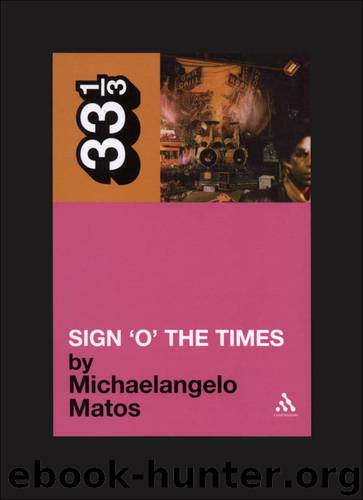Prince's Sign O' the Times by Matos Michaelangelo

Author:Matos, Michaelangelo
Language: eng
Format: epub
Publisher: Continuum International Publishing
Published: 2011-08-22T16:00:00+00:00
Lisa Coleman found herself playing the grand piano in the upstairs living room while the rest of the band huddled into the crowded basement studio. Connected only by mics and ear phones, the Revolution still managed to pull off the exquisite song in a single take—even the jazzy intro that Prince suggested just as the tape was ready to roll. “Power Fantastic” also serves to introduce the newest dimension in Prince’s music—the only instrument that he couldn’t play himself—horns.19
The most immediately striking thing about Sign ‘O’ the Times is the jazzy sensibility running through it. Prince’s father was a jazz musician, his mother a vocalist; he’d been a fan of chops-heavy jazz-fusion as well as rock and R&B growing up. But when Prince began recording for Warner Bros., he abjured the brass sections that dominated groups like Earth, Wind & Fire and Parliament-Funkadelic, opting instead for stacked synthesizer patterns and a spare, cold feel that markedly contrasted with lush, overarranged disco and the wild, thick underbrush of the era’s giant funk ensembles; Rickey Vincent, author of Funk: The Music, the People, and the Rhythm of the One, dubbed it “naked funk.” Getting away from traditional R&B instrumentation is an underappreciated aspect of Prince’s crossover success; Prince is also said to have actively disliked the sound of horns early in his career.
Like most things with Prince—his musical direction, his name, the sense-to-words ratio of his public statements—this changed. His first significant dabbling with horns came on Sheila E.’s 1984 single, “The Glamorous Life,” where they seem like a nod to Sheila’s background in Latin jazz, where she, like her father Coke Escovedo, was a star percussionist, playing with Azteca and George Duke. But they don’t feel tacked on: The horn figures are as Princely as the bounding synth runs and quirked-out lyrics, and fit the busy, hooky music like a lace glove. Ditto the sax/trumpet lines on Parade’s “Mountains.” Sign ‘O’ the Times is where he dives in completely, and he has continued using horns in his music: With the exception of Najee’s treacly saxophone, which helps torpedo 2001’s already torpid The Rainbow Children, Prince’s writing for horns is probably the most consistently intriguing feature of his post-Sign work, particularly on 1996’s Emancipation and 1992’s I’m Gonna Change My Name to the Title of This Album.
Eric Leeds and Matt Blistan appear on five Sign tracks: “Housequake,” “Slow Love,” “Hot Thing,” “It’s Gonna Be a Beautiful Night,” and “Adore.” 15 years after first listening to the album, I’d guessed the number was higher until I actually sat down and counted. But five songs are enough to color our perception of the rest of the album. Excepting “Adore,” where the trumpet and sax help thicken the overall sound without necessarily differentiating themselves from it, the Sign tracks with Leeds and Blistan feature horns as both foundation and icing: It’s impossible to imagine “Housequake” or “It’s Gonna Be a Beautiful Night” without their stuttering James Brown-redux riffs; “Hot Thing” takes off during Leeds’s hot-and-sleazy soloing, and “Slow Love” is practically a duet between Prince and the horn charts.
Download
This site does not store any files on its server. We only index and link to content provided by other sites. Please contact the content providers to delete copyright contents if any and email us, we'll remove relevant links or contents immediately.
Aircraft Design of WWII: A Sketchbook by Lockheed Aircraft Corporation(32192)
The Great Music City by Andrea Baker(31252)
Call Me by Your Name by André Aciman(20351)
The Secret History by Donna Tartt(18813)
The Art of Boudoir Photography: How to Create Stunning Photographs of Women by Christa Meola(18506)
Shoot Sexy by Ryan Armbrust(17637)
Plagued by Fire by Paul Hendrickson(17315)
Portrait Mastery in Black & White: Learn the Signature Style of a Legendary Photographer by Tim Kelly(16933)
Adobe Camera Raw For Digital Photographers Only by Rob Sheppard(16882)
Photographically Speaking: A Deeper Look at Creating Stronger Images (Eva Spring's Library) by David duChemin(16601)
Ready Player One by Cline Ernest(14498)
Pimp by Iceberg Slim(14328)
Bombshells: Glamour Girls of a Lifetime by Sullivan Steve(13954)
The Goal (Off-Campus #4) by Elle Kennedy(13484)
Art Nude Photography Explained: How to Photograph and Understand Great Art Nude Images by Simon Walden(12954)
Kathy Andrews Collection by Kathy Andrews(11709)
The Priory of the Orange Tree by Samantha Shannon(8867)
The remains of the day by Kazuo Ishiguro(8791)
Thirteen Reasons Why by Jay Asher(8770)
